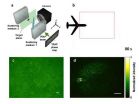(Press-News.org) Researchers from Australia report that low birth weight and preterm birth are linked to increased risk for osteoarthritis (OA)-related hip replacements in adulthood. Findings published in the American College of Rheumatology (ACR) journal, Arthritis Care & Research, indicate that low birth weight and pre-term babies were not at greater risk of knee arthroplasty due to OA as adults.
According to the ACR, 27 million Americans over the age of 25 are diagnosed with clinical OA. Symptoms of OA range from mild to severe and include pain, stiffness, and swelling of joints. In fact, OA is the most common cause of disability, with medical evidence reporting OA of the knees and hips totaling 71 million years lived with disability (2010)—a worldwide increase of 64% since 1990.
Lead investigator, Professor Flavia Cicuttini with the School of Public Health and Preventive Medicine at Monash University and Alfred Hospital in Melbourne, Australia says, "Currently there are no disease-modifying medications available to treat OA, which makes understanding the risk factors associated with OA so important for improving prevention of this disabling disease."
Previous research found that low birth weight and preterm birth have been linked to hypertension, cardiovascular disease, insulin resistance and reduced bone mass in adulthood. With understanding of these adverse outcomes, the research team set out to investigate if low birth weight and preterm birth also played a role in increased risk of joint replacement surgery as adults.
The present study used data from 3,604 participants of the Australian Diabetes, Obesity and Lifestyle Study who were 40 years of age or older at the time data of joint replacement surgeries were collected. Participants provided information about their weight at birth and if they were prematurely delivered. The participants' records were then linked to knee and hip replacements due to OA data (2002-2011) from the Australian Orthopaedic Association National Joint Replacement Registry.
Of the participants, 116 had knee replacement surgery and 75 underwent hip arthroplasty for OA. Low birth weight and preterm birth were linked to increase incidence of hip arthroplasty independent of age, sex, body mass index (BMI), education level, hypertension, diabetes, smoking and physical activity. Researchers found no significant association between low birth weight or preterm birth and knee replacement surgery.
"Our findings suggest that individuals born prematurely or with low birth weight are more likely to need hip replacement surgery for OA in adulthood," concludes Professor Flavia Cicuttini. "While further investigation is needed to confirm these findings, indentifying those at greatest risk for hip OA and providing early interventions may help reduce the incidence of this debilitating disease."
INFORMATION:
This study is published in Arthritis Care & Research. Media wishing to receive a PDF of this article may contact sciencenewsroom@wiley.com.
Full citation: "Association of Low Birth Weight and Preterm Birth with the Incidence Of Knee and Hip Arthroplasty for Osteoarthritis." Sultana Monira Hussain, Yuanyuan Wang, Anita E. Wluka, Jonathan E. Shaw, Dianna J. Magliano, Stephen Graves and Flavia M. Cicuttini Arthritis Care and Research; Published Online: November 3, 2014 (DOI: 10.1002/acr.22475).
URL Upon Publication: http://doi.wiley.com/10.1002/acr.22475
Author Contact: To arrange an interview with Dr. Cicuttini, please contact Rachael Fergusson with Monash University at +61 9903 4841 or +61 439 013 951 or by email at rachael.fergusson@monash.edu.
Media Advisory
2014 ACR/ARHP Annual Meeting Press Registration Now Open.
What: Registration is now open to journalists planning to attend the 2014 ACR/ARHP Annual Meeting in Boston.
Thousands of rheumatologists and rheumatology health professionals are expected to attend this year's meeting, which will highlight the latest advances in rheumatology research.
Where: Boston Convention Center; Boston, Mass.
When: November 15-19, 2014
Online Registration: To register for a press badge click here
Policies: Please make sure to review our press guidelines http://www.acrannualmeeting.org/Press as they may impact your ability to receive press credentials
Dates for this year's annual meeting:
Press registration closes: Monday, November 3
Press conference schedule announced: Early-October
On-site Newsroom opens: Saturday, November 15; 7:30 AM ET
Opening Lecture/Embargo lifts: Saturday, November 15; 4:30 PM ET
http://www.acrannualmeeting.org/Press or contact Bonny Senkbeil at (404) 633-3777 or via e-mail at bsenkbeil@rheumatology.org, 404-633-3777
About the Journal
Arthritis Care & Research is an official journal of the American College of Rheumatology (ACR), and the Association of Rheumatology Health Professionals (ARHP), a division of the College. Arthritis Care & Research is a peer-reviewed journal that publishes both original research and review articles that promote excellence in the clinical practice of rheumatology. Relevant to the care of individuals with arthritis and related disorders, major topics are evidence-based practice studies, clinical problems, practice guidelines, health care economics, health care policy, educational, social, and public health issues, and future trends in rheumatology practice. The journal is published by Wiley on behalf of the ACR. For more information, please visit the journal home page at http://wileyonlinelibrary.com/journal/acr.
About Wiley
Wiley is a global provider of content-enabled solutions that improve outcomes in research, education, and professional practice. Our core businesses produce scientific, technical, medical, and scholarly journals, reference works, books, database services, and advertising; professional books, subscription products, certification and training services and online applications; and education content and services including integrated online teaching and learning resources for undergraduate and graduate students and lifelong learners.
Founded in 1807, John Wiley & Sons, Inc. (NYSE: JWa, JWb), has been a valued source of information and understanding for more than 200 years, helping people around the world meet their needs and fulfill their aspirations. Wiley and its acquired companies have published the works of more than 450 Nobel laureates in all categories: Literature, Economics, Physiology or Medicine, Physics, Chemistry, and Peace. Wiley's global headquarters are located in Hoboken, New Jersey, with operations in the U.S., Europe, Asia, Canada, and Australia. The Company's website can be accessed at http://www.wiley.com.
Preterm, low birth-weight babies may need new hips in adulthood
2014-11-03
ELSE PRESS RELEASES FROM THIS DATE:
March of Dimes calls for 50 percent reduction in preterm births by 2030
2014-11-03
WHITE PLAINS, N.Y., Nov. 3, 2014 – The March of Dimes is calling for a nationwide effort to reduce U.S. preterm births to 5.5 percent of all live births by 2030. Seven other developed countries already have preterm birth rates below 6 percent, and 15 have rates below 7 percent.
The U.S. rate of 11.4 percent in 2013 is one of the highest. The U.S. ranked 37th out of 39 high resource countries in 2010.
"The United States spends more money per capita on health care than almost any other country in the world, and yet our premature birth rate and our infant mortality ...
Study reveals startling decline in European birds
2014-11-03
Bird populations across Europe have experienced sharp declines over the past 30 years, with the majority of losses from the most common species, say the University of Exeter, the RSPB and the Pan-European Common Bird Monitoring Scheme (PECBMS) in a new study. However numbers of some less common birds have risen.
The study, published today in the journal Ecology Letters, reveals a decrease of 421 million individual birds over 30 years. Around 90 percent of these losses were from the 36 most common and widespread species, including house sparrows, skylarks, grey partridges ...
Sea sponge drug could boost advanced breast cancer survival by 5 extra months
2014-11-03
THE cancer drug eribulin, originally developed from sea sponges, could give women with advanced triple negative breast cancer an average of five extra months of life, according to research presented at the National Cancer Research Institute (NCRI) Cancer Conference in Liverpool today (Monday).
Researchers led by Professor Chris Twelves, based at the University of Leeds and Leeds Teaching Hospitals NHS Trust, looked at two major clinical trials of more than 1,800 women with breast cancer that had started to spread to other parts of the body. The phase III trials – ...
The Lancet Diabetes & Endocrinology: Weight loss surgery substantially reduces the risk of developing type 2 diabetes
2014-11-03
Bariatric (weight loss) surgery, such as gastric bypass or gastric banding, could reduce the risk of developing type 2 diabetes by around 80% in obese people, compared with standard care, new research published in The Lancet Diabetes & Endocrinology journal suggests.
Being overweight or obese is the main modifiable risk factor for type 2 diabetes. More than 80% of adults with type 2 diabetes are overweight or obese [1]. In England, just over a quarter of adults (26%) were classified as obese in 2010 (body mass index [BMI] 30kg/m2 or over)[2]. Up to 3% of people with ...
Getting more out of nature: Genetic toolkit finds new maximum for crop yields
2014-11-02
Cold Spring Harbor, NY – Scientists at Cold Spring Harbor Laboratory (CSHL) today announced a new way to dramatically increase crop yields by improving upon Mother Nature's offerings. A team led by Associate Professor Zachary Lippman, in collaboration with Israeli colleagues, has discovered a set of gene variations that can boost fruit production in the tomato plant by as much as 100%.
Plant breeders will be able to combine different gene variants among the set to create an optimal plant architecture for particular varieties and growing conditions. The set of mutations ...
Sediment supply drives floodplain evolution in Amazon Basin
2014-11-02
A new study of the Amazon River basin shows lowland rivers that carry large volumes of sediment meander more across floodplains and create more oxbow lakes than rivers that carry less sediment.
The findings have implication for the Amazonian river system, which may be significantly altered by proposed mega-dams that would disrupt sediment supplies.
Researchers from Cardiff University's School of Earth and Ocean Sciences examined 20 reaches within the Amazon Basin from Landsat imagery spanning nearly 20 years (1985 to 2013).
They found rivers transporting larger amounts ...
Study: 'Wimpy' antibody protects against kidney disease in mice
2014-11-02
CINCINNATI—An antibody abundant in mice and previously thought to offer poor assistance in fighting against infection may actually play a key role in keeping immune responses in check and preventing more serious self-inflicted forms of kidney disease, researchers say.
Led by researchers at the University of Cincinnati (UC) and Cincinnati Children's Hospital Medical Center and published online Nov. 2, 2014, in the journal Nature, the study finds that the mouse antibody IgG1, which is made in large quantities and resembles a human antibody known as IgG4, may actually ...
Two photons strongly coupled by glass fiber
2014-11-02
Two photons in free space do not interact. Light waves can pass through each other without having any influence on each other at all. For many applications in quantum technology, however, interaction between photons is crucial. It is an indispensable prerequisite for transmitting information through tap-proof quantum channels or for building optical logic gates. At the Vienna University of Technology (TU Wien), scientists have now succeeded in establishing a strong interaction between two single photons. This opens up completely new possibilities for quantum optics. The ...
Improving imaging of cancerous tissues by reversing time
2014-11-02
As a child, it was fascinating to put a flashlight up to our palms to see the light shine through the hand. Washington University in St. Louis engineers are using a similar idea to track movement inside the body's tissues to improve imaging of cancerous tissues and to develop potential treatments.
Lihong Wang, PhD, the Gene K. Beare Distinguished Professor of Biomedical Engineering at the School of Engineering & Applied Science is applying a novel time-reversal technology that allows researchers to better focus light in tissue, such as muscles and organs.
Current ...
Mutant models
2014-11-02
Nate Silver and Richard Feynman walk into a bar and bump into a biologist . . .
While this may sound like the setup to some late-night nerd sketch, researchers have taken this premise and applied it to an increasingly cumbersome problem in modern biology, namely, finding meaning in the rising oceans of genomic data.
In this specific instance, the data comprisesreams of cancer mutations that genome-wide studies are publishing at a dizzying rate. The challenge is finding new and efficient ways to parse the signal from the noise (and there is no shortage of noise).
As ...



